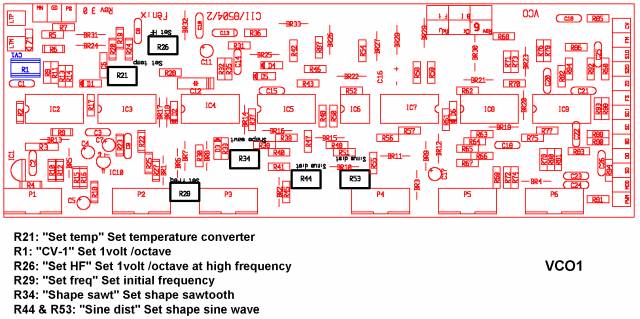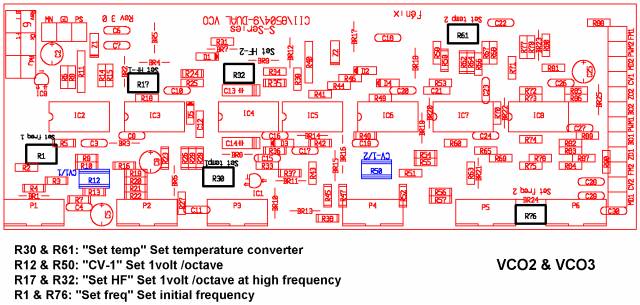Calibrating VCO
Why needs to calibrate.
There are some user who hase reported of tuning problems. After checking this problems we find that most of the time the problem was caused by external elements. Fi the output design of some midi-interfaces was causing these problems. The can not handle the input load of the the Fénix VCO's and VCF's. See also the servicing page for the solution.
An other problem is if you are using a synth with a cv output. The CV output could be slightly different as 1v/oct. Often the VCO's of this synth are calibrated with this keyboard. But if you using this keyboard CV out for controlling the VCO's of the Fénix the Fénix will sound out of tune. In this case you can choose to recallibrate the keyboard and the VCO of the synth or the Fénix VCO's, VCF's and CV-Mixer 2. The best thing to do is callibrate everything to the 1V/octave standard
How difficult is tuning the VCO
If this is your first time it probably will cost you a lot of time. The problem with tuning is that if you calibrate the VCO's two things happens. The 1v/oct change but also the initial frequency. Because of that you must repeat the calibration a number of time.
A way to calibrate is using your ear using a reference oscillator or using a frequency counter.
For each VCO there are 4 trimpots. One is for the temperature of the log converter, one is for the calibration the VCO at high frequency, one is for the initial frequency and the last is the 1v/oct trimpot. If you didn't replace components do not adjust the first 2.
VCO1 however has 3 trimpot extra for adjusting the shape of the triangle and the sinewave. At the PCB board of VCO 1 is one blue trimpot and st the PCB boards with VCO2 and VCO3 there are 2 blue trim pots, one for each VCO. These pots are for calibrating the 1v/oct
You need a voltage source for providing the control voltages.
As CV you can use the CV output of a external keyboard/synth, Midi to CV converter or the internal CV source (CV mixer 2)
The best is to choose the source you normaly use if you playing this instrument. Always use a mixer (with CV1 input)to buffer the control voltages to prevent errors due the design of some cv outputs.
You must open the Fénix to do this. Try to avoid extra air movement. Cover the top of the PCB board. Power the Fénix 15 minutes before you start.
Calibrating by ear.
You must need a reference VCO. This could be a VCO of a digital synthesiser. Set the reference VCO at about 110 Hz.
Connect the VCO at the a keyboard CV. Tune VCO with the reference VCO at zero beats with the frontpanel knobs.
Play one octave higher and try to tune (zero beats) the VCO with the blue trimpot. Play the original note and tune VCO with the frontpanel knob. Repeat until this is ok.
Calibrating with a frequency counter.
You can do this if you have a frequency counter. This frequency counter must have at least one digit behind the decimal point. In this case you don't need the reference oscillator.
Connect the VCO at the a keyboard CV. Set the VCO at 110 Hz.
Play one octave higher and try to tune at 220Hz the VCO with the blue trimpot. Play the original note and tune VCO with the frontpanel knob. Repeat until this is ok.
An other way to tune with a frequency counter is instead to retune the VCO with the frontpanel knob to use your brains. If you play the original key you will notice that the frequency has been changed. Fi 204,6 Hz. If you play 1 octave higher the note must be 409.2 Hz.
Calibrating the VCO at high frequency's,
This procedure is the same as above except you must use an other trimpot and the starting frequency is 1000Hz

